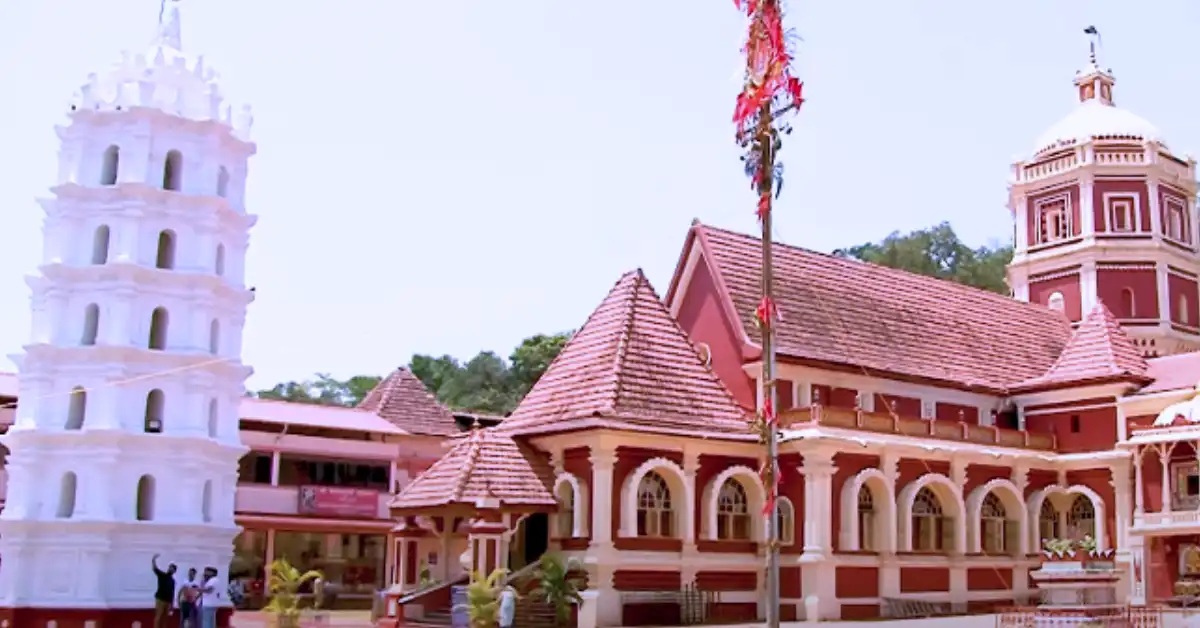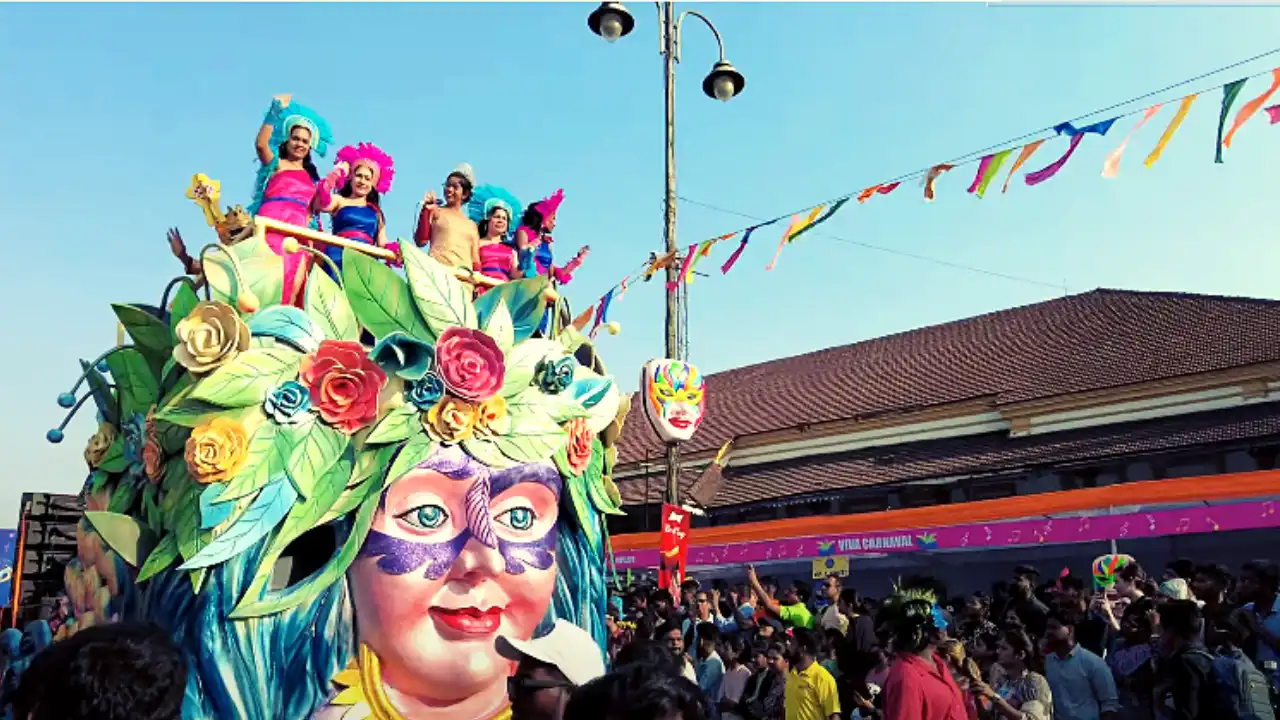
Shri Shantadurga Temple | Journey to Shri Shantadurga Temple – Ponda Goa
Nestled amidst the serene foothills of Kavalem village in Ponda, Goa, lies the enchanting Shri Shantadurga Temple, a sanctuary of peace and spiritual harmony. Steeped in history and devotion, this sacred abode traces its origins back to a humble mud shrine, where the revered deity, Shantadurga, was first enshrined. It was in the year 1730 that the foundation stone was laid for the transformation of this modest structure into the magnificent temple it stands as today. By 1738, this labor of love and faith was completed, a testament to the devotion of its worshippers.
Dedicated to Shantadurga, the divine mediator between the mighty presences of Vishnu and Shiva, the temple holds within its walls the echoes of ancient legends. Local lore speaks of a titanic clash between the cosmic forces of Vishnu and Shiva, a battle so fierce that it threatened the very fabric of existence. In that dire moment, it was Shantadurga who emerged, embodying the serene power of peace and reconciliation. With her divine grace, she quelled the tumultuous conflict, placing Vishnu and Shiva under her protective embrace, thus restoring harmony to the universe.
Read More: Majorda Beach | Your Guide to Travel, Location, Activities & Accommodation
Inviting the Divine Presence
Today, Shri Shantadurga Temple stands not only as a place of worship but also as a symbol of cultural heritage and spiritual heritage. It serves as a beacon of devotion for the Goud Saraswat Brahman community, whose faith in their beloved Kuldevi, Shantadurga, remains unwavering through the passage of time. Under the spiritual guidance of the revered Shrimad Swamiji of Shri Kavale Math, the temple continues to be a source of solace and inspiration for pilgrims and seekers alike, beckoning them to experience the divine presence that dwells within its sacred precincts.
Deity – The Deity of Shri Shantadurga Temple
The temple is all about Shantadurga, who helps Vishnu and Shiva. People also call her ‘Santeri’ casually. According to stories, there was a big fight between Shiva and Vishnu. It got so bad that Brahma prayed to Parvati, asking for help. Parvati then took the form of Shantadurga and stopped the fight. She put Vishnu on one side and Shiva on the other, making peace between them.
Shantadurga is shown holding two snakes, one in each hand, which represent Vishnu and Shiva. Shrimat Shivananda Saraswati Swami Gauḍapādāchārya from Shri Kavale Math leads Shree Shantadurga Saunsthan, Kavale.
Preserving Heritage: Shri Shantadurga Temple Complex
The original Shantadurga Temple at Quelossim faced destruction by the Portuguese in 1566. However, the goddess was relocated to Kavalem, where worship continued. The original temple site, known as “Deoolbhata,” is now under the ownership of the Shree Shantadurga Saunsthan Committee, Kavale. The current temple was constructed during the Maratha Empire under Chattrapati Shahu Maharaj of Satara between 1713 and 1738.
Read More: Temple Chandreshwar Bhootnath | Oldest Temple – Paroda Goa
Situated amidst lush vegetation on the foothills, the temple complex features a main temple and three smaller ones dedicated to various deities. With pyramidal roofs and a dome, the temple boasts pillars and floors made of Kashmir stone. Additionally, it houses a large tank, a Deep Jyoti Stambh, and guest houses.
Over the years, the main temple and others have undergone numerous renovations, including the agrashalas. Notably, the temple recently restricted entry for foreigners due to concerns over inappropriate attire and behavior.

Crafting Beauty | Saraswat Style at Shri Shantadurga Temple
The Shri Shantadurga Temple is a splendid example of Saraswat architectural style. Its distinctive features include pyramid-shaped shikaras adorning the roofs of the entrance hall and the main hall, along with Roman-arched windows adorned with vibrant stained-glass panes in hues of red, yellow, blue, and green. Chandeliers, gate posts, and a balustraded flat dome further enhance its beauty.
Adding to its allure is the temple’s maroon-peach-white color scheme, imparting a serene and enchanting ambiance. One of its most striking features is the golden palanquin used to carry the deity during festive occasions, particularly during the grand celebration of Mahapanchmi, held only five times a year.
Conclusion on Shri Shantadurga Temple
In conclusion, Shri Shantadurga Temple is not just a place of worship; it’s a treasure trove of history, culture, and beauty. From its humble beginnings to its grandeur today, the temple’s journey reflects the resilience and devotion of its worshippers. The stories of gods and goddesses come alive within its walls, captivating hearts and minds alike. Whether it’s the serene surroundings or the intricate architecture, every aspect of the temple resonates with a sense of peace and wonder. It’s a place where people of all ages can come together to find solace, inspiration, and a deeper connection with the divine.
Frequently Asked Questions
What is the significance of Shri Shantadurga Temple?
Shri Shantadurga Temple holds great importance as a sacred place of worship dedicated to the goddess Shantadurga, who mediates between Vishnu and Shiva, bringing peace and harmony.
Who built Shri Shantadurga Temple?
The temple was constructed during the reign of the Maratha Empire, under the patronage of Chattrapati Shahu Maharaj of Satara, between 1713 and 1738.
What architectural style is used in Shri Shantadurga Temple?
The temple showcases the Saraswat architectural style, characterized by pyramid-shaped shikaras, Roman-arched windows with stained-glass panes, and a balustraded flat dome.
What is the significance of the golden palanquin at the temple?
The golden palanquin is used to carry the deity during festive occasions, particularly during Mahapanchmi celebrations, adding grandeur and splendor to the festivities.
Why was entry restricted for foreigners at Shri Shantadurga Temple?
Entry was restricted due to concerns over inappropriate attire and behavior, ensuring that the sanctity and serenity of the temple are maintained for all worshippers.
Read More: Tambdi Surla Temple – Mahadev Temple

